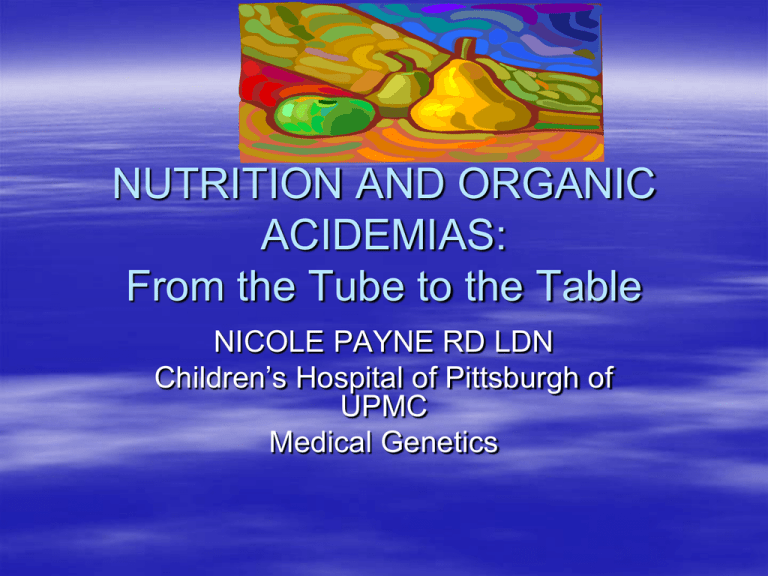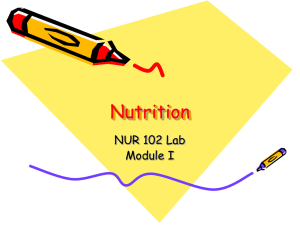Conference Talk - Organic Acidemia Association
advertisement

NUTRITION AND ORGANIC ACIDEMIAS: From the Tube to the Table NICOLE PAYNE RD LDN Children’s Hospital of Pittsburgh of UPMC Medical Genetics Preview General nutrition guidelines Individual symptom management Transitioning from tube to oral intake NUTRITION SUPPORT GOALS 1. Provide enough macro and micro nutrients to ensure proper growth and development • • Protein requirements are greater than DRI when L-amino acids are primary protein source Vitamin and minerals should be provided at the greatest intakes suggested for each age group NUTRITION SUPPORT GOALS 2. Prevent fasting/catabolism – Allow infants to fast no longer than 4-6 hours; older children and adults no longer than 8 hours – If ill, recommend Pedialyte, GatorAde, fruit juices – If unable to take anything orally, hospital admission for IV dextrose NUTRITION SUPPORT GOALS 3. Correct the primary imbalance in the metabolic pathway • Restrict, through diet, the accumulation of the substrate that is toxic • Supply products of the blocked pathway • Supplement cofactors and ‘conditionally essential’ nutrients GOALS OF NUTRITION THERAPY 4. Manage individual symptoms • • • • failure to thrive swallowing difficulties oral aversions GI disturbances (vomiting, diarrhea, constipation) Monitor In adults, weigh at home weekly and at doctor’s office every 6 months In children, weigh at home weekly, at doctor’s office at least every 3 months with height check. If failure to thrive or tube fed, doctor/dietitian monthly. Case of Scooby Doo 10 y/o male with Propionic Acidemia Identified by NBS and started on treatment at 6 days of life Breast fed first week of life, poor suck-reflex and reflux Spent weeks in NICU with IVs and NG tube Sent home at 1 month of age; bottle fed a combination of Propimex-1 and pumped breast milk Frequent admissions requiring IV dextrose and NG feeds during first few year of life By 14 months of age, Scooby only tolerating small amount of high calorie Propimex1/Pediasure (30 calories per ounce) by bottle; very small volume of baby foods. He dropped 2 percentiles on growth chart for weight. Not taking any solid foods. Failure to Thrive Weight in young infants or height in children under 2 that consistently falls below the 3rd %ile for age Failure to maintain an established growth curve Weight for height that falls below the 10th %ile on growth curve Weight deceleration across 2 or more major %iles Weight loss of >10% in a previously healthy child Aspiration indicators Coughing and choking during feeding Increased congestion Increased fussiness during feeding Frequent or persistent respiratory illnesses Persistent low grade fever Wet vocal quality during or after feeding Failure to progress to the next developmental level of feeding Pureeing Food Recommend pureed table foods over baby foods if age appropriate Recommend using a blender or food processor for anything the family is eating Add extra high calorie fluids such as oil, gravy, broth, spaghetti sauce Pour puree into ice cue trays and freeze, most ice cubes are 30 mL Goal for weight gain Focus on highly preferred foods Every calorie counts Fortify foods to add extra calories Choose high calorie food options, look at brands Alternative forms of Nutrition IV – provides hydration and electrylytes TPN – provides nutrition when GI tract can not be used Tubes: Oral-gastric, Naso-gastric, Nasojejunal, Gastric, and Gastro-jejunal (GJ) Benefits of Gastric Tube Feeding (G-Tube) Decrease stress in child and family Continue to feed for pleasure, if safe Use only at night-time Provide an excellent source of nutrition Can use for medications and metabolic formula Types of Administration Continuous Bolus Night time Continuous Feedings Run on a pump at a set rate for up to 24 hours per day Pros: – Often times most easily tolerated – Will prevent fasting catabolism Cons: – Does not allow for normal hunger/satiety cycle – Individual must be connected to tubing 24 hours per day Night Feedings Run on a pump but over night only, may be anywhere from 8-12 hours Pros: – Allows for time disconnected from tubing during the day – Often times most easily tolerated – Eliminates night time catabolism Cons: – Does not allow for normal hunger/satiety cycle Bolus Feedings Set volume is given over a short period of time, may be given via syringe push, gravity or run on pump at high rate Pros: – Allows for normal hunger satiety cycle – Allows for time disconnected from tubing – Can subtract amount consumed orally Cons: – May not be tolerated by some individuals – Must be given frequently enough to prevent catabolism Photo of G-tube G-tube Mickey Button Gets G-tube at 20 months of age Starts with continuous feeds, advances to continuous feeds at night only with daytime bolus feeds Shorter stays in hospital Scooby starts growing and gaining weight well Important Therapy for Tube Fed Child Feeding therapist: • Modify utensils (smaller spoons, cut- out cups, larger/smaller nipple holes) • Chew/swallow techniques (chin tuck, towling, proper feeding positioning) • Determine appropriate consistency for foods and liquids • Reduce oral aversions through play and behavior modification Age 6, Scooby enters school and makes friends Takes interest in eating foods Voices desire to have tube removed…. What does Scooby need to do?? Progression from Tube Feedings to Oral Feeding Must consistently consume 60 mL (2 ounces) of solids per day Family is educated on fortifying foods to 1 calorie per mL Adjust tube-feedings to allow for time off prior to oral feedings If possible, adjust to all daytime bolus feedings and cut down on night feedings Family or care takers record all intakes Progression from Tube Feedings to Oral Feeding Tube feedings are decreased as oral intake increases May recommend appetite stimulant, such as Periactin, if agreeable with MD Recommend tube removal after two bouts of illness without use and consistent weight gain and growth Goal to decrease tube-feeds Volume is more of a goal than variety Boost oral calories by fortifying foods Focus on preferred foods Easier textures often go more quickly Goal to increase volume Focus on set meal times rather than grazing Work towards a set, daily meal schedule that is consistent Utilize preferred foods at all meals Remember, a calorie is a calorie Caloric Supplementation Infants Formula - increase caloric density of formula Strained foods - choose high calorie foods, fortify with infant cereal, Polycose, Benecal, Duocal & oil Toddlers Increase caloric density: – Add flavoring to formula (strawberry syrup, KoolAde, Sunny D) – Fruits and Juices: Calorie supplement and/or sugar, maple syrup, non dairy whip – Entrees/vegetables: add oils, gravies, sauces, margarine – Snacks: add butter to crackers and popcorn, non dairy whip to pudding, sugar to cereal Typical diet recall Breakfast: ½ cup cheerios, 4 ounces rice milk, 4 ounces fruit juice, ½ banana, 4 ounces formula Lunch: 2 slices bread, 1 Tbsp jelly, 4 ounces salad/dressing, 1 apple, 8 ounces water, 4 ounces formula Dinner: ½ cup rice, ½ cup green beans, 8 ounces water, 4 ounces formula Calorie Fortified Meal Plan Add sugar to cheerios, add Duocal to fruit juices, add oil/butter to veggies and rice Add in between meal and before bed snacks of pudding with non dairy whip, hard-boiled egg yolk, crackers with margarine Add 1 Tbsp strawberry syrup to flavor formula; use juice instead of water For an extra: 850 kcals Real Food Fortifiers Margarine Butter Sugar Olive oil Wheat germ Non dairy cream Maple syrup or honey\ Sundae topping syrups Commercial Fortifiers Polycose – liquid or powder Duocal MCT oil Benefiber Thick it



